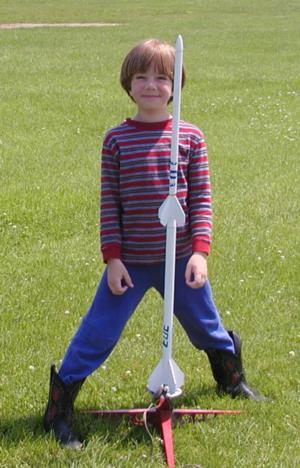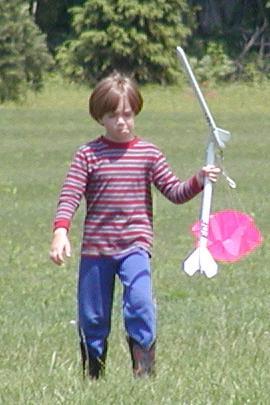Scratch Eliminator of Eliminators Original Design / Scratch Built
Scratch - Eliminator of Eliminators {Scratch}
Contributed by Bob Patterson
| Manufacturer: | Scratch |
 Brief:
Brief:
Two rocket assemblies designed to be flown as one single stage rocket, or flown
as 2 independent rockets. Parachute/streamer for recovery selected on a whim
depending on wind conditions.
Construction:
All components are from an Estes Designer Special kit from some years ago.
- Fin shape (balsa) selected by 7 year old son, with lower fins scaled up in size from upper fins.
- Wood nosecones & coupler used in both pieces.
- Upper stage accepts B6/C6 size engine directly when flown separately.
- Lower stage is diameter of a D12 engine, but built with adapter ring so that it also launches with B6/C6 size engine.
- Swivel eye hooks used for all attachments to allow easy field changes.
- If launched as dual unit, coupler stays in upper stage - can be recovered with separate parachute, or use 'chute attached to lower stage.
Construction method is very straightforward. Son selected tubes and nosecones, then found coupler to allow one to sit on the other. He picked the fin shape, which I copied onto balsa sheet and cut/sanded to match.
Paint is Krylon white, with crude masking used for hand painting of blue EOE lettering. Eliminator of Eliminators - to shoot down the Estes Eliminator rocket we had completed prior to this one!
I drew the letters for the lower stage on masking tape, he did the upper. Then I cut out the letters, taped in place, and the holes were painted in. Didn't turn out too bad.
 Flight:
Flight:
We had previously launched the lower stage by itself with no difficulties.
This morning (6-31-02) we launched them assembled as one unit. I elected to have both halves come down on one 'chute as I wasn't sure what the winds were going to do, and wanted it to come down sooner rather than later in one place and not two.
Setup was as follows (remembering that all attachments are made with swivel hooks to screw eyes in wood):
- The upper nosecone was attached to top of the coupler via elastic cord and the coupler inserted.
- The bottom of the coupler was attached to the lower stage's elastic band (this rocket was assembled prior to my finding Kevlar® Yarn from Pratt Hobbies).
- The parachute was attached to the bottom of the coupler, as was a piece of Pratt Hobbies Heat shield (Kevlar® cloth) via Kevlar® yarn.
- Cloth, chute, and coupler were installed, then a C6-5 engine and it was off to the launchpad.
Flight went up doing 3-4 pretty tight but easily observable spirals, and the ejection charge blew normally.
However, instead of coming down as 2 pieces dangling from one chute, somehow after ejection the lower body got jammed onto one of the fins of the upper body, and the whole assemblage came down in an upside down V under the parachute.
Damage is minimal - one slightly cracked fin, and the lower body tube slightly torn in two places where it got jammed.
Next time, if more eyes are available for tracking, we will allow it to come in two separate pieces.
Summary:
Pros - the rocket was easy to build, and flew pretty nicely. The swivel hooks
(found in Walmart fishing department) allow easy configuration changes in the
field.
Cons - the decision to keep the two halves connected detracted from the recovery. I wonder if perhaps the lower stage rubber band snapped the two halves back together after ejection. Perhaps a longer distance between the two (via Kevlar® yarn) would have allowed for cleaner separation. Certainly separate recovery would have.
Not sure what I could have done to prevent the spiral flight - not sure I can put fins on any straighter than I did.
Other:
Get involved with your kids - my son had a blast choosing the design. He
selected all the components, picked the paint scheme, enjoyed helping to paint
it, and really enjoyed launching it and then chasing it down. Granted, I did
all the assembly, but he's only 7, and maybe by next summer he won't mind
getting glue on his fingers and will have enough patience to hold fins in place
while the glue dries.
 |
 |